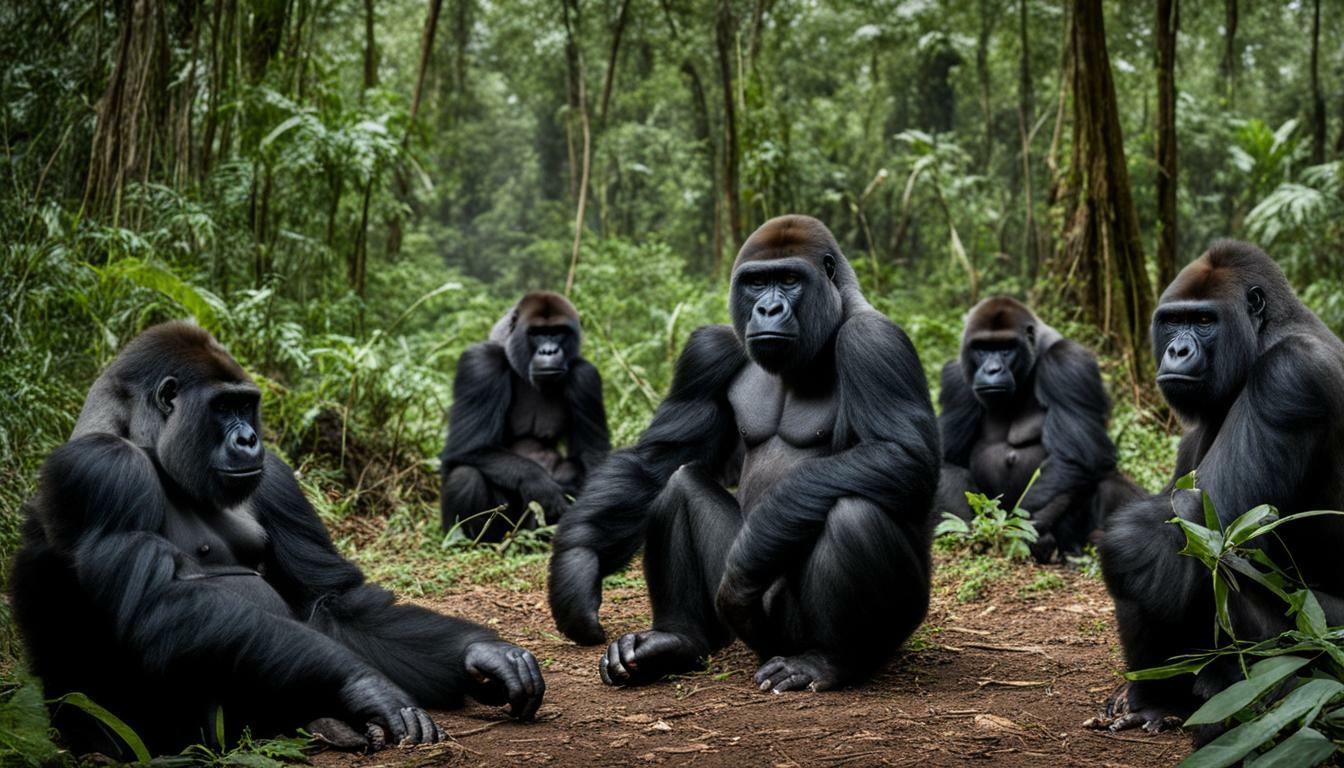Gorilla poaching is a pressing concern that threatens the survival of these endangered animals, and understanding the statistics behind it is crucial. In Africa, thousands of gorillas and other endangered animals fall victim to illegal killings by poachers every day. This illegal wildlife trafficking is driven by the lucrative black market trade, estimated to be worth $5-$23 billion per year. Rhino poaching is also a major concern, with one rhino being poached every 12 hours. The number of rhinos has drastically decreased, leaving only around 29,000 remaining worldwide. Alarmingly, Vietnam has become a major hub for rhino horn poaching, where a pound of rhino horn fetches between $15,000 and $30,000. Gorillas face their biggest threat from the commercial trade in bushmeat, as apes are hunted and killed primarily to meet the demand in urban centers. While hunting, trading, and consuming gorillas is illegal in Congo Basin countries, the lack of enforcement and ineffective judiciary systems contribute to ongoing poaching. Gorillas also face the dangers of traps and snares, resulting in maiming or death. These magnificent animals are sought after as pets, trophies, and for their body parts, which are used in traditional medicine and as magical charms. The combination of low reproductive rates and persistent hunting makes gorillas vulnerable to population declines. It is evident that urgent action is needed to combat gorilla poaching and protect these magnificent animals from the brink of extinction.
Key Takeaways:
- Gorilla poaching poses a significant threat to the survival of these endangered animals.
- Illegal wildlife trafficking in Africa is estimated to be worth $5-$23 billion per year.
- Rhino poaching is a major concern, with one rhino being poached every 12 hours.
- Vietnam has become a major hub for rhino horn poaching, with high prices ranging from $15,000 to $30,000 per pound.
- The commercial trade in bushmeat is the biggest threat to gorillas, driven by the demand in urban centers.
- Enforcement and judiciary systems in Congo Basin countries struggle to combat gorilla poaching effectively.
- Gorillas face dangers from traps and snares, leading to maiming or death.
- Gorillas are sought after for pets, trophies, and traditional medicine uses.
- Gorillas have low reproductive rates, making them vulnerable to population declines.
The Impact of Gorilla Poaching
The poaching of gorillas has had a devastating impact on their already endangered populations, posing significant challenges to conservation efforts and endangering the future of these majestic creatures. In Africa, thousands of endangered animals, including gorillas, are killed by poachers every day. This illegal wildlife trafficking is driven by the lucrative black market trade, which is estimated to be worth $5-$23 billion per year.
Rhino poaching is also a major concern, with rhinos being poached at a rate of one every 12 hours. The number of rhinos has significantly dropped, with only around 29,000 left in the world. The biggest rhino horns poaching hub is in Vietnam, where a single pound of rhino horn can be sold for $15,000 to $30,000.
The commercial trade in bushmeat is the biggest threat to gorillas, with apes being killed for meat, primarily to supply the high-end demand in urban centers. The hunting, trading, and consumption of gorillas is illegal in Congo Basin countries, but a lack of enforcement and ineffective judiciary systems contribute to the ongoing poaching. Gorillas have low reproductive rates, making them vulnerable to population declines caused by hunting. They are also frequently maimed or killed by traps and snares. Gorillas are sought after as pets, trophies, and for their body parts, which are used in traditional medicine and as magical charms.
Overall, these statistics highlight the urgent need to address gorilla poaching and protect these magnificent animals from extinction.
| Poaching Statistics | Conservation Efforts | Poaching Threats |
|---|---|---|
| – Thousands of endangered animals are killed by poachers every day. | – Conservation efforts are challenged by the illegal wildlife trade. | – Commercial trade in bushmeat poses a significant threat to gorillas. |
| – Rhino poaching happens at a rate of one every 12 hours. | – The number of rhinos has significantly declined. | – Gorillas are frequently maimed or killed by traps and snares. |
| – Illegal wildlife trafficking is worth $5-$23 billion per year. | – Gorillas have low reproductive rates, making them vulnerable to population declines. | – Gorillas are sought after as pets, trophies, and for their body parts. |
Uncovering the Stark Reality: Gorilla Poaching Statistics
By examining the wildlife crime data and African ape poaching rates, the shocking reality of gorilla poaching comes to light, revealing the urgent need for action. Gorilla poaching is a significant issue that poses a threat to the survival of these endangered animals. In Africa, thousands of gorillas and other endangered animals are killed by poachers every day. This illegal wildlife trafficking is driven by the lucrative black market trade, estimated to be worth $5-$23 billion per year.
The commercial trade in bushmeat is the biggest threat to gorillas, with apes being killed for meat, primarily to supply the high-end demand in urban centers. The hunting, trading, and consumption of gorillas is illegal in Congo Basin countries, but a lack of enforcement and ineffective judiciary systems contribute to the ongoing poaching. Gorillas have low reproductive rates, making them vulnerable to population declines caused by hunting. They are also frequently maimed or killed by traps and snares. Gorillas are sought after as pets, trophies, and for their body parts, which are used in traditional medicine and as magical charms.
“Rhino poaching is also a major concern, with rhinos being poached at a rate of one every 12 hours. The number of rhinos has significantly dropped, with only around 29,000 left in the world. The biggest rhino horns poaching hub is in Vietnam, where a single pound of rhino horn can be sold for $15,000 to $30,000,” says Dr. Jane Goodall, renowned primatologist and conservationist.
| Statistics: | Impact: |
|---|---|
| Gorillas killed by poachers daily | Threat to the survival of gorilla populations |
| Value of the black market trade | Driving force behind gorilla poaching |
| Rhinos poached every 12 hours | Concern for overall wildlife conservation |
| Number of rhinos remaining in the world | Significant decline in rhino populations |
The statistics speak for themselves, underscoring the urgent need to address gorilla poaching and protect these magnificent animals from extinction. Time is of the essence, and concerted efforts are required to combat this devastating phenomenon. By raising awareness, strengthening enforcement, and supporting conservation initiatives, we can make a difference and ensure a future where gorillas can thrive in their natural habitats.
Combating Gorilla Poaching: Anti-Poaching Initiatives and Wildlife Trafficking Figures
To combat gorilla poaching, various anti-poaching initiatives have been implemented, and understanding the wildlife trafficking figures is vital in assessing the effectiveness of these efforts. The fight against gorilla poaching requires a multi-faceted approach that involves collaboration between local communities, government agencies, conservation organizations, and international bodies.
One such initiative is the deployment of anti-poaching rangers who patrol protected areas and work tirelessly to deter and apprehend poachers. These dedicated individuals put their lives on the line to safeguard gorilla populations. In addition to on-the-ground efforts, technology plays a crucial role in combating poaching. Tools such as drones, GPS tracking devices, and camera traps are utilized to monitor and gather data on poaching activities, enabling authorities to respond swiftly and effectively.
Another key strategy is disrupting the illegal wildlife trade networks. By targeting wildlife traffickers and dismantling their operations, law enforcement agencies can significantly impact the supply chain. This requires collaboration between countries to strengthen border controls, enhance intelligence sharing, and support capacity-building initiatives. Moreover, raising public awareness of the consequences of wildlife trafficking can help reduce demand and discourage individuals from participating in this criminal activity.
Understanding wildlife trafficking figures is essential to evaluating the progress made in combating gorilla poaching. These figures provide insights into the scale of the problem and help guide resource allocation and policy decisions. They also serve as a benchmark to measure the success of anti-poaching initiatives and identify areas in need of further intervention. By constantly monitoring and analyzing wildlife trafficking figures, stakeholders can adapt their strategies and focus their efforts where they are most impactful, ultimately working towards the protection and preservation of gorilla populations.
| Anti-Poaching Initiatives | Key Components |
|---|---|
| Ranger patrols | Increased surveillance and deterrence in protected areas |
| Technology | Utilization of drones, tracking devices, and camera traps for monitoring |
| Disrupting wildlife trade | Targeting traffickers, strengthening border controls, and raising public awareness |
By implementing these anti-poaching initiatives and staying vigilant about wildlife trafficking figures, we can make significant strides in the fight against gorilla poaching. It is crucial that we continue to support and expand these efforts to ensure the survival of these magnificent animals and protect the delicate ecosystems they inhabit.
The Urgent Need for Protection: Ensuring the Survival of Gorillas
The survival of gorillas hangs in the balance, and urgent action is required to protect these endangered animals from the devastating impact of poaching and ensure their long-term existence. Wildlife trafficking figures reveal the alarming magnitude of this issue, with thousands of gorillas falling victim to poachers each day. The demand for gorilla body parts, bushmeat, and pets continues to fuel illegal wildlife trade, contributing to the decline of these majestic creatures.
A disturbing statistic sheds light on the severity of the problem: the black market trade, which includes gorilla poaching, is estimated to be worth a staggering $5-$23 billion annually. This lucrative industry incentivizes poachers to continue their illegal activities, leading to the loss of countless gorilla lives. The commercial trade in bushmeat poses a significant threat to gorillas, as they are hunted and killed for their meat, which caters to the high-end demand in urban areas.
Enforcement and judicial systems in Congo Basin countries, where gorillas are protected, often struggle to effectively combat gorilla poaching. This weak governance allows poachers to continue their illegal activities, leaving gorilla populations vulnerable. Compounding the problem, gorillas have low reproductive rates, making them more susceptible to population declines caused by hunting. They also face additional risks, such as injuries and fatalities from traps and snares set by poachers.
Gorillas are not only valued for their meat; they are also sought after for their body parts, which are used in traditional medicine and as magical charms. The illegal pet trade and trophy hunting further contribute to their decline. These practices threaten the very existence of gorillas in the wild, emphasizing the urgent need for comprehensive protection measures to safeguard their future.
| Statistics | Figures |
|---|---|
| African wildlife trafficking worth | $5-$23 billion per year |
| Rate of rhinos poached | One every 12 hours |
| Number of rhinos left in the world | Approximately 29,000 |
| Price of a pound of rhino horn in Vietnam | $15,000 to $30,000 |
Conclusion
To safeguard the future of gorillas, it is crucial that we unite in our efforts to combat gorilla poaching and preserve the beauty and diversity of our natural world.
Gorilla poaching is a significant issue that poses a grave threat to the survival of these endangered animals. Every day, thousands of endangered animals, including gorillas, fall victim to poachers in Africa. This illegal wildlife trafficking is fueled by the lucrative black market trade, estimated to be worth $5-$23 billion per year.
Rhino poaching also remains a major concern, with one rhino being poached every 12 hours. The number of rhinos has plummeted, leaving only around 29,000 remaining worldwide. Vietnam stands out as the largest hub for rhino horn poaching, where a single pound of rhino horn can fetch a staggering $15,000 to $30,000.
However, the commercial trade in bushmeat poses the most significant threat to gorillas. Apes are killed for their meat, predominantly to meet the high-end demand in urban centers. Hunting, trading, and consuming gorillas are prohibited in Congo Basin countries, but a lack of enforcement and ineffective judiciary systems contribute to the ongoing poaching. Gorillas have low reproductive rates, making them highly vulnerable to population declines caused by hunting. Additionally, they frequently suffer from injury or death due to traps and snares. Furthermore, gorillas are targeted as pets, trophies, and for their body parts, which are sought after in traditional medicine and as magical charms.
These statistics paint a stark picture that emphasizes the urgent need to address gorilla poaching and protect these magnificent animals from the brink of extinction. By raising awareness, supporting anti-poaching initiatives, and strengthening the enforcement of wildlife protection laws, we can make a significant difference in ensuring the survival of gorillas. Together, let us take a stand and preserve the beauty and diversity of our natural world, for the sake of future generations and the magnificent gorillas who call it home.
What Impact Does Poaching Have on the Conservation of Giraffes and Other Wildlife?
Poaching has a devastating impact on the conservation of giraffes and other wildlife. The illegal hunting and killing of these animals disrupts their populations and can lead to orphaned giraffe calf care. By reducing the number of these majestic creatures, poaching threatens the balance of entire ecosystems.
FAQ
Q: What is gorilla poaching?
A: Gorilla poaching refers to the illegal hunting and killing of gorillas for various purposes, such as bushmeat, pet trade, trophies, and body parts used in traditional medicine.
Q: Why is gorilla poaching a significant issue?
A: Gorilla poaching poses a severe threat to the survival of these endangered animals. It contributes to population declines, disrupts ecosystems, and undermines conservation efforts.
Q: How many gorillas are killed by poachers every day?
A: The exact number is difficult to determine, but thousands of endangered animals, including gorillas, are killed by poachers in Africa each day.
Q: What is the value of the black market trade in illegal wildlife trafficking?
A: The black market trade in illegal wildlife trafficking is estimated to be worth $5-$23 billion per year. This lucrative industry drives the demand for gorilla products and fuels poaching.
Q: How many rhinos are poached every 12 hours?
A: Rhinos are poached at a rate of one every 12 hours. This is a major concern, as it has led to a significant drop in their population, with only around 29,000 left in the world.
Q: Where is the biggest rhino horns poaching hub?
A: The biggest rhino horn poaching hub is in Vietnam. A single pound of rhino horn can be sold for $15,000 to $30,000, making it a highly sought-after commodity in the illegal wildlife trade.
Q: What is the biggest threat to gorillas?
A: The commercial trade in bushmeat is the biggest threat to gorillas. Apes are killed for meat, primarily to supply the high-end demand in urban centers, contributing to their decline.
Q: Is hunting, trading, and consumption of gorillas illegal?
A: Yes, the hunting, trading, and consumption of gorillas is illegal in Congo Basin countries. However, a lack of enforcement and ineffective judiciary systems contribute to ongoing poaching.
Q: Why are gorillas vulnerable to population declines caused by hunting?
A: Gorillas have low reproductive rates, making them vulnerable to population declines caused by hunting. This means that even a small number of killings can have a significant impact on their overall population.
Q: Why are gorillas sought after?
A: Gorillas are sought after as pets, trophies, and for their body parts. Their body parts are used in traditional medicine and as magical charms, driving the demand for illegal trade.
Q: What is the urgent need to address gorilla poaching?
A: The statistics highlight the urgent need to address gorilla poaching and protect these magnificent animals from extinction. Immediate action is necessary to preserve their populations and ecosystems.











